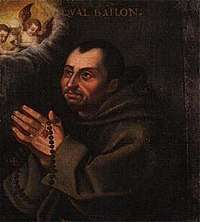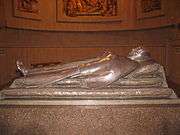Paschal Baylon
| Paschal Baylón OFM | |
|---|---|
 | |
| Religious | |
| Born |
16 May 1540 Torrehermosa, Aragon Spain |
| Died |
17 May 1592 (aged 52) Villarreal, Aragon Kingdom Spain |
| Venerated in | Roman Catholic Church |
| Beatified | 29 October 1618, Saint Peter's Basilica, Papal States by Pope Paul V |
| Canonized | 16 October 1690, Saint Peter's Basilica, Papal States by Pope Alexander VIII |
| Feast | 17 May |
| Attributes |
|
| Patronage |
|
Paschal Baylón OFM (16 May 1540 – 17 May 1592) was a Spanish Roman Catholic lay professed religious of the Order of Friars Minor. He served as a shepherd alongside his father in his childhood and adolescence, but desired to enter the religious life. He was refused once but later was admitted as a Franciscan lay brother and became noted for his strict austerities, as well as his love for and compassion towards the sick. He was sent to counter the arguments of the Calvinists in France but was chased out and nearly killed by a mob. He was best known for his strong and deep devotion to the Eucharist.
His piety drew people from all over seeking his counsel, and at his death caused, miracles were reported at his tomb. The process for his canonization opened and in 1618 he was beatified; Pope Alexander VIII canonized him a saint on 16 October 1690.
Early life
Paschal Baylón was born on 16 May 1540 at Torrehermosa, in the Kingdom of Aragon, on the feast of the Pentecost to the poor but pious peasants Martin and Elizabeth Jubera Baylón.[3] The fact that he was born on the feast of Pentecost led to his parents naming him "Pàscuàl" (Paschal). He had at least two older siblings.
He spent his childhood and adolescence as a shepherd, and as he toiled in the fields remained attentive to the sound of the church bell which rang during the Elevation during the Mass. Paschal was very honest, and once offered to reimburse the owners of crops damaged due to his animals getting loose.
He carried a book with him into the fields where he watched the sheep, and ask those that he met to teach him the letters; and so, in a short time, being still quite young, he learned to read. Paschal in his poverty joined alms with his continual prayer; and not having any other means to relieve the poor, always gave them a good part of his own dinner which was sent him into the fields.[4] Some of his companions were much inclined to cursing, quarrelling, and fighting; but learnt to hold their tongue in his presence since they respected his pious nature and his virtue.[3]
Friar
Those to whom he first mentioned his inclination to a religious life, recommended several richly endowed monasteries, but he answered,"I was born poor and am resolved to die in poverty and penance".[4]
In 1564 he joined the Reformed Franciscans as a religious brother and commenced his period of novitiate on 2 February before making his profession on 2 February 1565 in Orito at the Saint Joseph convent. He was urged to become an ordained priest but he felt that was not the path for him.[3] But he was once denied the chance to join on the account of his age prompting him to return to his duties as a shepherd before the order had a change of heart and admitted him into their ranks.[1]
He had never more than one habit, and that always threadbare. He walked without sandals in the snows, and in the roughest roads. He accommodated himself to all places and seasons, and was always content, cheerful, mild, affable, and full of respect for all.[4] His jobs included serving as a cook and porter as well as the gardener and the official beggar who went around asking for alms. He lived this life in contemplation and silent meditation and often did this as he worked. He was a contemplative and had frequent ecstatic visions. He would spend the night before the altar in silence during some nights to commune with God and to meditate on the faith. But he also shrugged off those notions of him gaining a reputation coming from that pious nature. His superior sent him to France in 1576 to have him defend the Real Presence against the blasphemies of a Calvinist preacher. But he was despised there and was almost killed after a Huguenot mob chased him out.[2][1] Those chasing him hurled stones and dirt at him causing him to break his shoulder and become bruised.[5]
The humble friar never wasted food. The end of each week saw him eat a few boiled vegetables which had been soaked in water with the terrible smelling weed known as wormwood. He often ate scraps from the kitchen. Other austerities included wearing a coat with steel spikes or a patched habit including one tunic lined with rough pig hair designed to cause discomfort. Sometimes he slept out in the cold.[5]
He died on 17 May after being taken ill; this day is also his feast day.
Veneration

His tomb in Villarreal became an immediate place of pilgrimage and there were soon miracles that were reported at his tomb. Pope Paul V beatified him on 29 October 1618 while Pope Alexander VIII canonized him later on 16 October 1690. In 1730 an indigenous Guatemalan claimed to have had a vision of a sainted Paschal appearing as a robed skeleton. This event became the basis of the heterodox tradition of San Pascualito.[6]
He was enlisted in the church's struggle against Modernism part of which was through increasing devotion towards the Eucharist; Pope Leo XIII[7] proclaimed the saint as the "seraph of the Eucharist" as well as the patron of Eucharistic congresses and affiliated associations. Art often depicts him wearing the Franciscan habit and bearing a monstrance which signifies his devotion to the Holy Eucharist. Pope John XXIII named the saint as the patron for the Segorbe diocese on 12 May 1961.[1]
During the Red Terror at the time of the Spanish Civil War his grave was desecrated and anticlerical leftists had his relics burned though some remained. Those that did were later transferred in the presence of King Juan Carlos I on 12 May 1992.[1]
Towns
- Saint-Paschal in Québec
- Saint-Pascal Baylon in Ontario
- San Pascual
See also
Notes and references
- 1 2 3 4 5 6 7 "San Pasquale Baylon". Santi e Beati. Retrieved 13 October 2017.
- 1 2 3 4 "Saint Pascal Baylon". Saints SQPN. 8 October 2017. Retrieved 13 October 2017.
- 1 2 3 Foley OFM, Leonard. "St. Pascal Baylon". Franciscan Media. Retrieved 13 October 2017.
- 1 2 3 Butler, Alban. "St. Pascal Baylon", The Lives or the Fathers, Martyrs and Other Principal Saints, 1864, D. & J. Sadlier, & Company

- 1 2 "Saints Who Loved the Blessed Sacrament". Society of Saint Pius X in Canada. Retrieved 13 October 2017.
- ↑ Feldman, Lawrence H. (1999). The War Against Epidemics in Colonial Guatemala, 1519-1821. C&M Online Media, Inc. pp. 23–27. ISBN 1-886420-60-2.
- ↑ In the Apostolic Brief Providentissimus Deus on 28 November 1897.
External links
| Wikimedia Commons has media related to Paschal Baylon. |